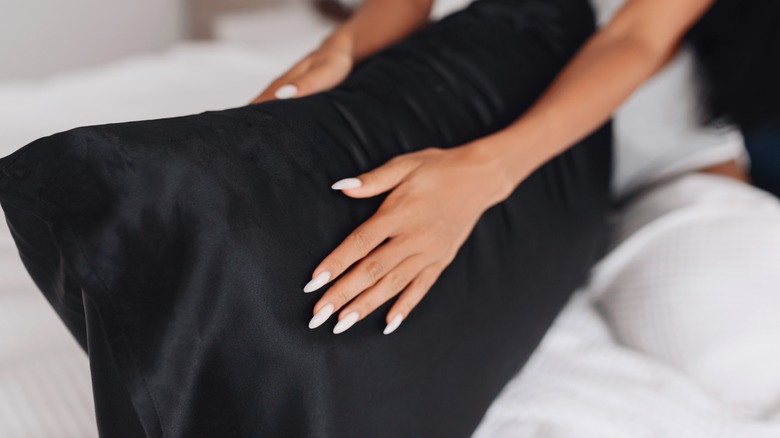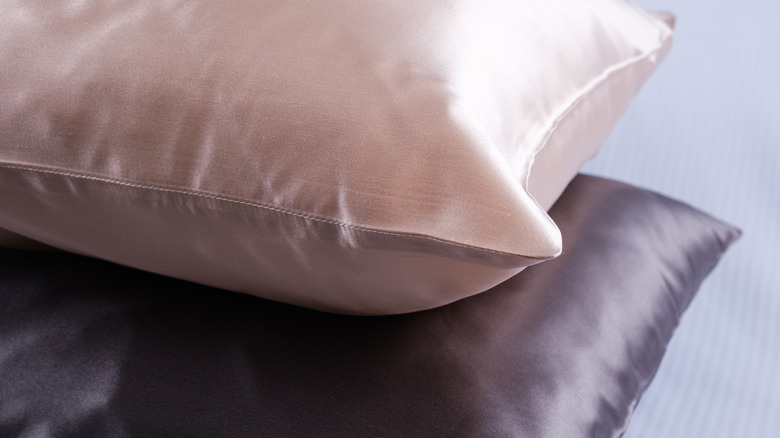Do Anti-Acne Pillowcases Really Work?
When looking for ways to prevent or treat acne, the usual move is to look at skincare products that can do the trick. However, very few people look at their beds for the real culprit behind their acne. Although you can find pore-clogging items almost anywhere, your pillow is filled with them. According to Silent Night, pillows should be replaced every two to three years, depending on the fabric and materials. Believe it or not, pillows house various sorts of bacteria, insects, and dead skin cells, all of which could wreak havoc on your skin. In fact, your pillow can hold up to 16 different types of bacteria, meaning there's plenty of chance that acne flare-ups can happen just from your pillow.
While you can constantly wash your pillowcases to ensure your skin remains clean, more options have popped up that can further help against acne. Typically pillowcases will come in a cotton material, which absorbs bacteria and dust easier and can trap it into the material for a lot longer. Reaching for another material may help as they might not hold onto dirt and dust as easily as cotton. However, as much as these different pillowcases claim to help reduce your acne, it's essential to question whether the solution for your acne breakouts is as simple as switching your pillowcases.
Are anti-acne pillowcases worth it?
For those looking for some extra protection against acne breakouts, rest assured that silk pillowcases will help. Ecosa explains that silk pillowcases make for the ideal anti-acne pillowcase because the fabric can defeat acne-causing bacteria on multiple fronts. Silk fabric is hypoallergenic, meaning that allergens, such as dirt, bacteria, and bugs, do not stick to the fabric. As well, silk doesn't absorb your facial oils, meaning anything on your skin stays on your skin while anything that can cause acne can't enter your skin. Silk fabric is softer on your skin and won't cause as much friction against your face. When you are constantly moving around in your silk, a rough pillowcase can cause irritation and acne, silk will help your face constantly glide around without hurting your skin.
Dermatologist, Dr. Anna Chacon, tells Mulberry Park Silks, "Cotton also sops up the natural oil and bacteria from your face and hair, and that grime accumulates on your pillowcase night after night, creating a bacteria petri dish out of your pillow. Silk pillowcases absorb less of the moisture and dirt, thus can be considered a better choice for people with acne or sensitive skin." In other words, the breathable aspect of silk can help your face remain clean and fresh throughout the night, no matter what season you find yourself in.
What you need to know about silk pillowcases
While silk pillowcases protect you against acne, there are still factors you need to keep in mind before purchasing your new pillowcase. Blissy recommends taking an extra look at your silk pillowcases before purchasing. Many times people can get confused between a silk and satin pillowcase and assume they are the same material. However, satin refers to the way the material was made as opposed to the actual material. Satin pillowcases could end up being made out of other fabrics, such as cotton and polyester. Pure silk pillowcases are the ones that will give you the right anti-acne benefits you seek.
The experts at SilkUp also recommend washing your silk pillowcases often. Washing your pillowcases every two to three days will help ensure that any dirt that manages to get absorbed gets cleaned out quickly. Besides dirt, other factors, like leftover makeup, can easily remain on your pillowcases, also causing acne struggles. You want to wash your pillowcases, along with your other bedding, in a fragrance-free wash. Certain chemicals behind fragrances could irritate your skin and cause acne breakouts.


